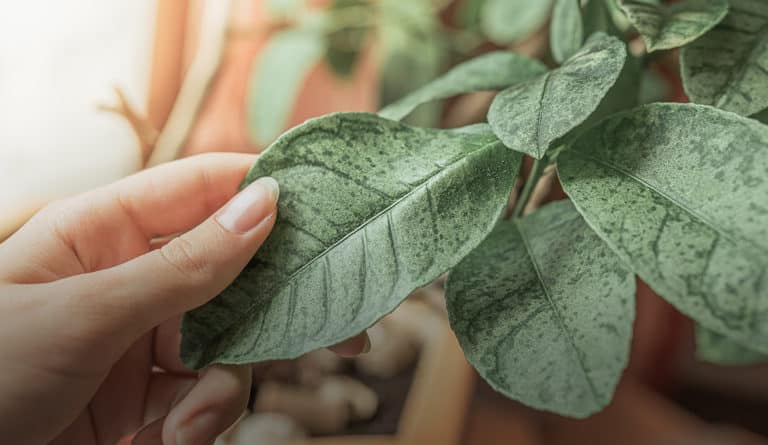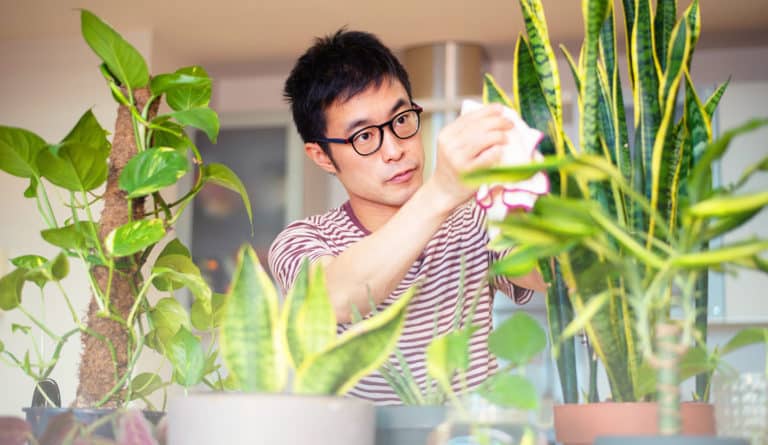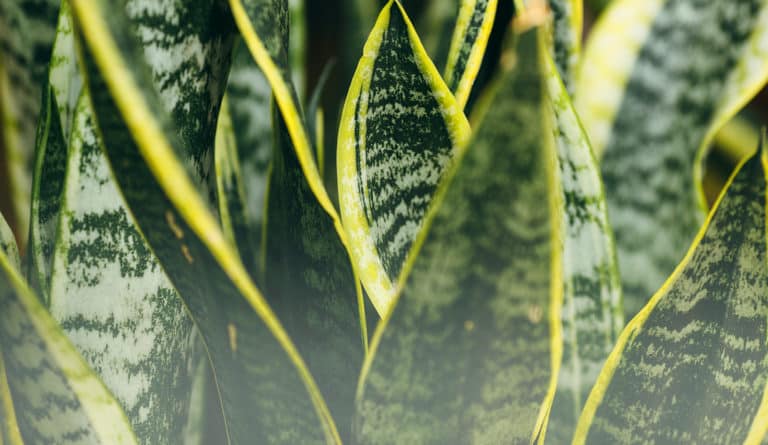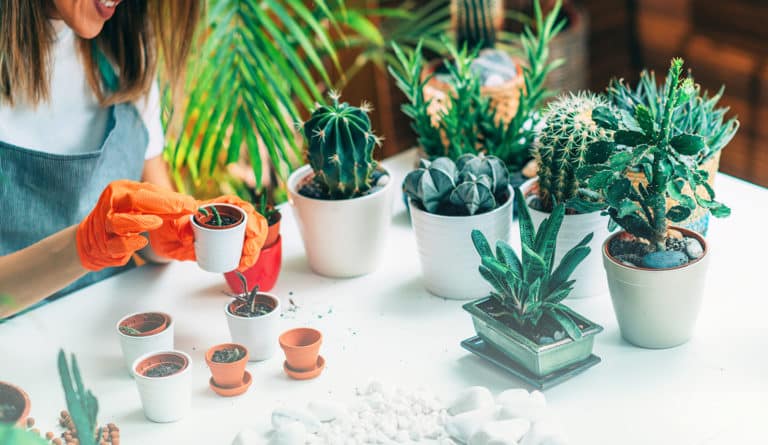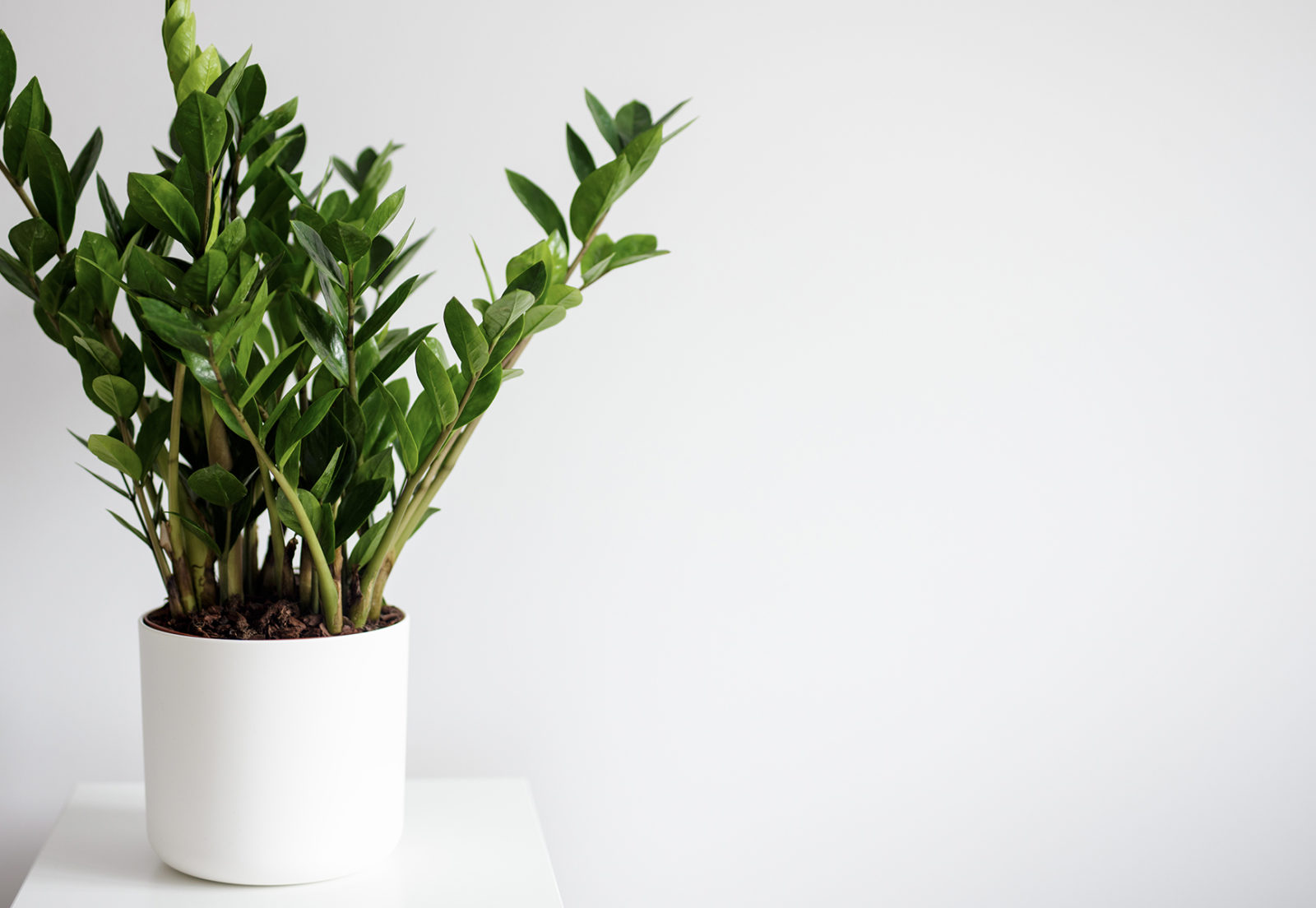
zz plant
aka zamioculcas zamiifolia, zuzu, emerald palm, zanzibar, zanzibar gem, eternity plant
ZZ has such impossibly gorgeous and glossy foliage that many people mistake them as fake. So glossy, so exotic and so low maintenance. In fact this sturdy stunner is sometimes mistaken as a fake plant. It may look too perfect be real, but it is! Meet to the Gem of Zanzibar, ZZ. Description: leaves so glossy and bright looks fake / thrives on neglect / easter and southern Africa / subtropical savannah / easy to grow / beginner plant
variations
There are a few varieties of ZZ, the Raven ZZ with black leaves, the Zenzi with curly bunched up leaves, the Dwarf ZZ or Zamicro which looks the same as a common ZZ but will never grow larger than 2 feet, and the Lucky classic which had more rounded leaves. You can also get variegated leaves on a ZZ.
light
flexible
Happiest in bright, indirect light. One of the few houseplants that can handle some hours of direct sun. But this easy-going beauty is also good in low light. So adaptable.
water + feeding
get dry between watering
Perhaps the only way to kill a ZZ is overwatering. It’s thick waxy coating and water-storing roots mean this plant does well with much less water than other plants. Make sure the top 1 to 2 inches are completely dry before rewatering. It also doesn’t need much feeding. Feed once a month max, in Spring and Summer. Even then, you can dilute the nutrients.
toxic
mildly toxic to humans and pets
Ingestion will cause mouth, stomach irritation and possible vomiting. ZZ’s sap may also cause skin irritation.
location
not fussy
ZZ can thrive almost anywhere. It truly is one of the easiest plants. It’s from Zanzibar, so it prefers the warmth.
humidity
flexible
Dry air is not a problem. It can handle humidity also. You can mist occasionally, but ZZ does well with no special treatment.
size
large friend
This plant can grow up to 5ft tall with a 3 to 4 foot spread.
pro tip
drought tolerant
ZZ plants have thick succulent roots and can live for months with little to no water. They much prefer to live on less water than too much.
fun fact
eternity plant
ZZ earned this nickname because it looks like ancient plants that predate the dinosaurs. Another reason may be its borderline miraculous resilience.
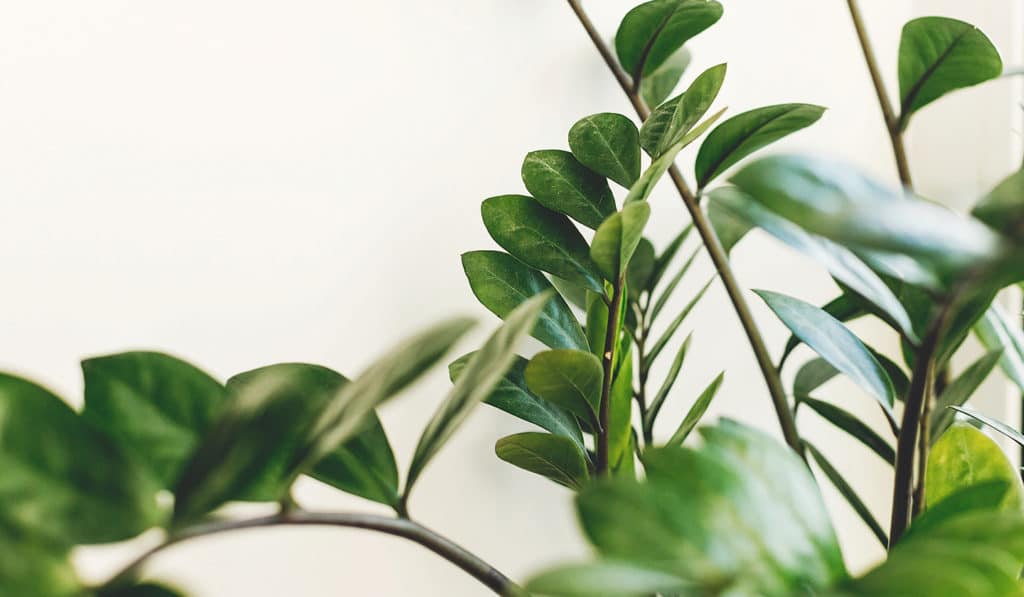
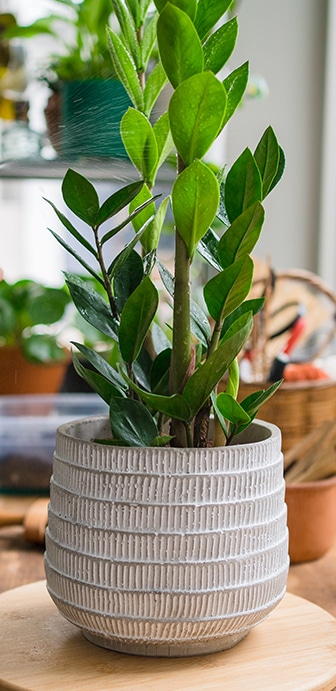
beyond the basics
-
soil & potting
ZZ prefers a light, well-draining potting soil like Miracle-Gro Cactus, Palm and Succulent Potting Mix. Or, use regular potting soil and add some potting sand or perlite. Ensure the pot has good drainage and avoid standing water. Empty drainage trays if you see water collecting.
-
when to repot
In the right light, ZZ grows quickly. Amazingly, they actually enjoy being a little rootbound, so you don’t need to repot as often as other plants. Repot every 3 to 4 years in the Spring, especially with younger plants. Increase pot by 2 inches every time. If you want to slow down growth, do some root trimming. In later years you can replace the top couple inches of soil instead of completely repotting.
-
propagation
Even propagation is easy with ZZ. Dig up the thick root ball and cut it in half. You can technically propagate your ZZ via stem and leaf cuttings, but it’s so much harder than cutting the root ball that we don’t recommend it.
-
pest control
Can get mealybugs and spider mites. When you’re dusting those glossy leaves, inspect the undersides. Check out our Pest control section in Plant 101 for how to identify and deal with pests on your plant!
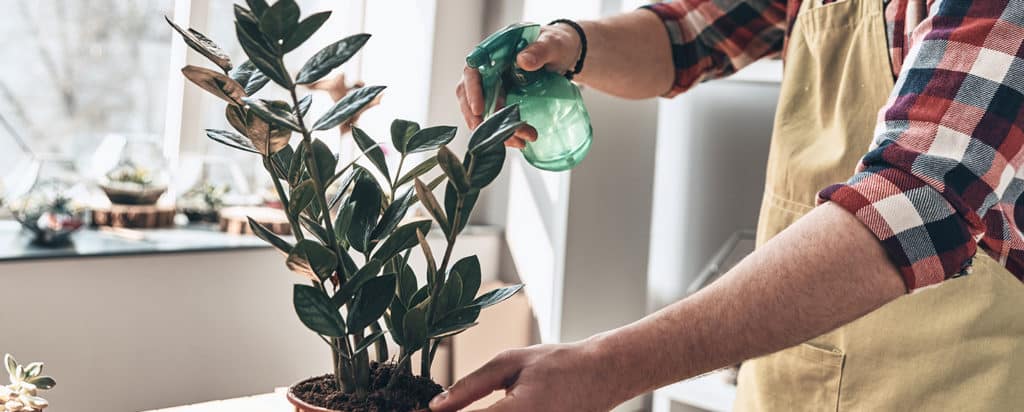
troubleshooting
-
why the yellowing leaves?
Overwatering. By far the most common problem with ZZ. Especially in Winter when it doesn’t need (or want) much water at all. If the plant has been sitting in water, it may have root rot. This problem is no big deal if you catch it early. First, stop watering! Let’s dry out that soil. Check your pot’s drainage. Does it have a hole that allows excess water to escape? Help things dry by poking holes in the soil. This will get oxygen to the roots. You can also put the pot (with drainage holes) in a tray that’s lined with a layer of dry soil. It acts like a sponge to draw out extra moisture. Now, let’s check for root rot. Dig down and cut out any that look affected. If things are really bad, consider repotting entirely with new soil. Moving forward, allow ZZ’s soil to dry between watering. The top couple inches should be dry to the touch. For more information check out our Plant 101 section.
-
why do I have many dropping leaves?
Probably stressed. ZZ is tough but not invincible. If you’ve moved it recently that may have stressed it out. Did you just bring it home from the nursery? That’s a big change. Leaf drop is most common when ZZ was in shade and suddenly put in full sun. Ease you plant to new area when you can. If you haven’t moved it recently, check for wet or totally bone-dry soil. See above for proper watering regimen.
-
what’s with the brown patches on leaves?
Sunburn. It can handle some direct sun, but long Summer exposure can burn even the mighty ZZ. Try moving your plant somewhere that’s still bright, but with indirect light.
-
why isn’t it growing?
Not enough light. ZZ survives well in low light, but it takes bright light for ZZ to thrive and grow. If you’re happy with the size, keep it shady. If you want to see ZZ’s impressive growth in action, move it somewhere with plenty of bright and mostly indirect light. Make this change gradually if you can. Increase your watering (but just a bit) to suit the increased light.
-
why the soft or drooping stems?
Again, overwatering. This is stem rot, spreading up from root rot. Remove all those mushy stems or trim away anything that looks like rot. Now let’s dry the soil and check the roots. Check your pot’s drainage. Does it have a hole that allows excess water to escape? Help things dry by poking holes in the soil. This will get oxygen to the roots. You can also put the pot (with drainage holes) in a tray that’s lined with a layer of dry soil. It acts like a sponge to draw out extra moisture. Now, let’s check for root rot. Dig down and cut out any that look affected. If things are really bad, consider repotting entirely with new soil. Moving forward, allow ZZ’s soil to dry between watering. The top couple inches should be dry to the touch. For more information check out our Plant 101 section.

zz plant
aka zamioculcas zamiifolia, zuzu, emerald palm, zanzibar, zanzibar gem, eternity plant
ZZ has such impossibly gorgeous and glossy foliage that many people mistake them as fake. So glossy, so exotic and so low maintenance. In fact this sturdy stunner is sometimes mistaken as a fake plant. It may look too perfect be real, but it is! Meet to the Gem of Zanzibar, ZZ. Description: leaves so glossy and bright looks fake / thrives on neglect / easter and southern Africa / subtropical savannah / easy to grow / beginner plant
variations
There are a few varieties of ZZ, the Raven ZZ with black leaves, the Zenzi with curly bunched up leaves, the Dwarf ZZ or Zamicro which looks the same as a common ZZ but will never grow larger than 2 feet, and the Lucky classic which had more rounded leaves. You can also get variegated leaves on a ZZ.
light
flexible
Happiest in bright, indirect light. One of the few houseplants that can handle some hours of direct sun. But this easy-going beauty is also good in low light. So adaptable.
water + feeding
get dry between watering
Perhaps the only way to kill a ZZ is overwatering. It’s thick waxy coating and water-storing roots mean this plant does well with much less water than other plants. Make sure the top 1 to 2 inches are completely dry before rewatering. It also doesn’t need much feeding. Feed once a month max, in Spring and Summer. Even then, you can dilute the nutrients.
toxic
mildly toxic to humans and pets
Ingestion will cause mouth, stomach irritation and possible vomiting. ZZ’s sap may also cause skin irritation.
location
not fussy
ZZ can thrive almost anywhere. It truly is one of the easiest plants. It’s from Zanzibar, so it prefers the warmth.
humidity
flexible
Dry air is not a problem. It can handle humidity also. You can mist occasionally, but ZZ does well with no special treatment.
size
large friend
This plant can grow up to 5ft tall with a 3 to 4 foot spread.
pro tip
drought tolerant
ZZ plants have thick succulent roots and can live for months with little to no water. They much prefer to live on less water than too much.
fun fact
eternity plant
ZZ earned this nickname because it looks like ancient plants that predate the dinosaurs. Another reason may be its borderline miraculous resilience.
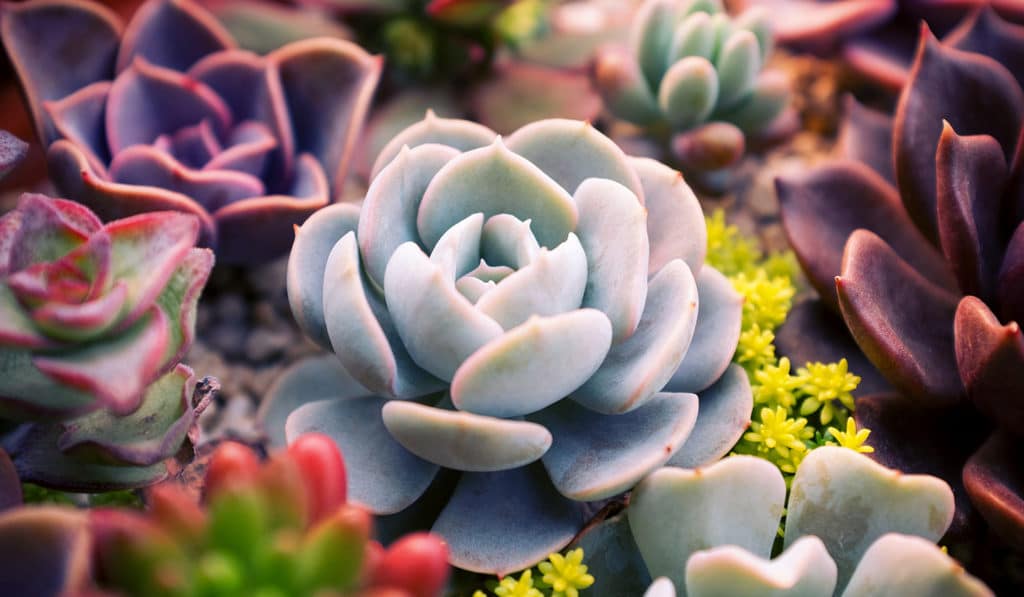
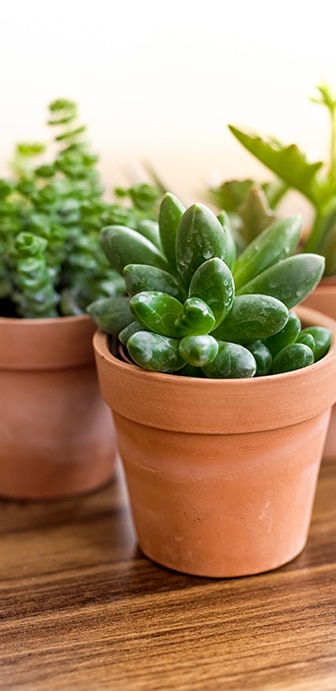
beyond the basics
-
soil & potting
These desert dwellers prefer a light, well-draining potting soil like Miracle-Gro Cactus, Palm and Succulent Potting Mix. Or, use regular potting soil and add some potting sand or perlite. A layer of sand on the top will help prevent rot. Ensure the pot has good drainage and aloe should never sit in water. Empty drainage trays if you see water collecting.
-
when to repot
Repot every 1 to 2 years in the Spring, especially with younger plants. Increase pot diameter by 2 inches every time. Want them to stay cute and little? You can stunt the growth by root trimming. In later years you can replace the top couple inches of soil instead of completely repotting.
-
propagation
Making new succulent plant babies is easy. In fact many propagate on their own. You will notice little mini versions starting grow. These “pups” can be gently separated potted as a new plant. If you’re not getting pups, remove a leaf, let it dry for a couple of days and place it on some moist soil. It should sprout roots, and voila! You have an ultra mini plant.
-
pest control
Succulents don’t typically suffer from pests, but they can sometimes get bugs. Gnats are most likely. Inspect those juicy little leaves regularly. Check out our Pest control section in Plant 101 for how to identify and deal with pests on your plant!
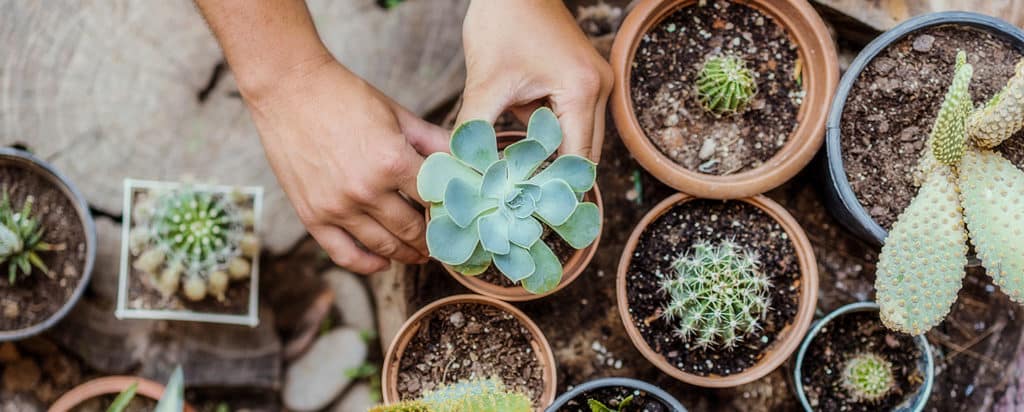
troubleshooting
-
why are the eaves turning brown, red or reddish brown?
A couple of possibilities. Maybe too much direct summer sun. Or possibly overwatering or root damage. First, moving your plant to a still-bright but less sun-blasted spot. Reduce the watering and follow our watering instructions above. If your succulent buddy still doesn’t bounce back, check for root damage.
-
what’s causing these dark spots? brown or mushy leaves?
Almost certainly too much water. This problem is no big deal if you catch it early. First, stop watering! Let’s dry out that soil. Check your pot’s drainage. Does it have a hole that allows excess water to escape? Help things dry by poking holes in the soil. This will get oxygen to the roots. You can also put the pot (with drainage holes) in a tray that’s lined with a layer of dry soil. It acts like a sponge to draw out extra moisture. Now, let’s check for root rot. Dig down and cut out any that look affected. If things are really bad, consider repotting entirely with new soil. Moving forward, water only when the soil is totally dry and make sure you water the soil, not the leaves. Water can collect between the leaves at its base, and start to rot. A thin layer of sand on top of the soil can reduce pooling water up top.
For more information check out our Plant 101 section.
-
pale or yellowing leaves?
Not enough light and/or overwatering. If the whole plant has yellowed or gone pale, it definitely needs more light. Move your friend to a brighter spot and resist the urge to overwater. Let the top two inches of soil get dry before watering again.
-
ew, what’s with the shrunken, wrinkled leaves?
Your plant needs a drink. Underwatering a succulent is hard to do, but it does happen. Give small amounts of water for three days in a row. Make sure you do this at soil level, not poured on the leaves. This is the ONE TIME it’s okay to do a little misting. A little does a lot. Resist the urge to water all at once! Your friend will plump up in a few days.
-
why isn’t my succulent growing?
Not enough light. It takes a lot of bright (mostly indirect) light to get succulents growing. If you’re not noticing any growth, or the new growth looks pale, it’s time to move to brighter spot. You may need slightly more frequent watering after the move. Note, succulents grow in slow motion at the best of times, so a little patience goes a long way.

zz plant
aka zamioculcas zamiifolia, zuzu, emerald palm, zanzibar, zanzibar gem, eternity plant
ZZ has such impossibly gorgeous and glossy foliage that many people mistake them as fake. So glossy, so exotic and so low maintenance. In fact this sturdy stunner is sometimes mistaken as a fake plant. It may look too perfect be real, but it is! Meet to the Gem of Zanzibar, ZZ. Description: leaves so glossy and bright looks fake / thrives on neglect / easter and southern Africa / subtropical savannah / easy to grow / beginner plant
variations
There are a few varieties of ZZ, the Raven ZZ with black leaves, the Zenzi with curly bunched up leaves, the Dwarf ZZ or Zamicro which looks the same as a common ZZ but will never grow larger than 2 feet, and the Lucky classic which had more rounded leaves. You can also get variegated leaves on a ZZ.
light
flexible
Happiest in bright, indirect light. One of the few houseplants that can handle some hours of direct sun. But this easy-going beauty is also good in low light. So adaptable.
water + feeding
get dry between watering
Perhaps the only way to kill a ZZ is overwatering. It’s thick waxy coating and water-storing roots mean this plant does well with much less water than other plants. Make sure the top 1 to 2 inches are completely dry before rewatering. It also doesn’t need much feeding. Feed once a month max, in Spring and Summer. Even then, you can dilute the nutrients.
toxic
mildly toxic to humans and pets
Ingestion will cause mouth, stomach irritation and possible vomiting. ZZ’s sap may also cause skin irritation.
location
not fussy
ZZ can thrive almost anywhere. It truly is one of the easiest plants. It’s from Zanzibar, so it prefers the warmth.
humidity
flexible
Dry air is not a problem. It can handle humidity also. You can mist occasionally, but ZZ does well with no special treatment.
size
large friend
This plant can grow up to 5ft tall with a 3 to 4 foot spread.
pro tip
drought tolerant
ZZ plants have thick succulent roots and can live for months with little to no water. They much prefer to live on less water than too much.
fun fact
eternity plant
ZZ earned this nickname because it looks like ancient plants that predate the dinosaurs. Another reason may be its borderline miraculous resilience.
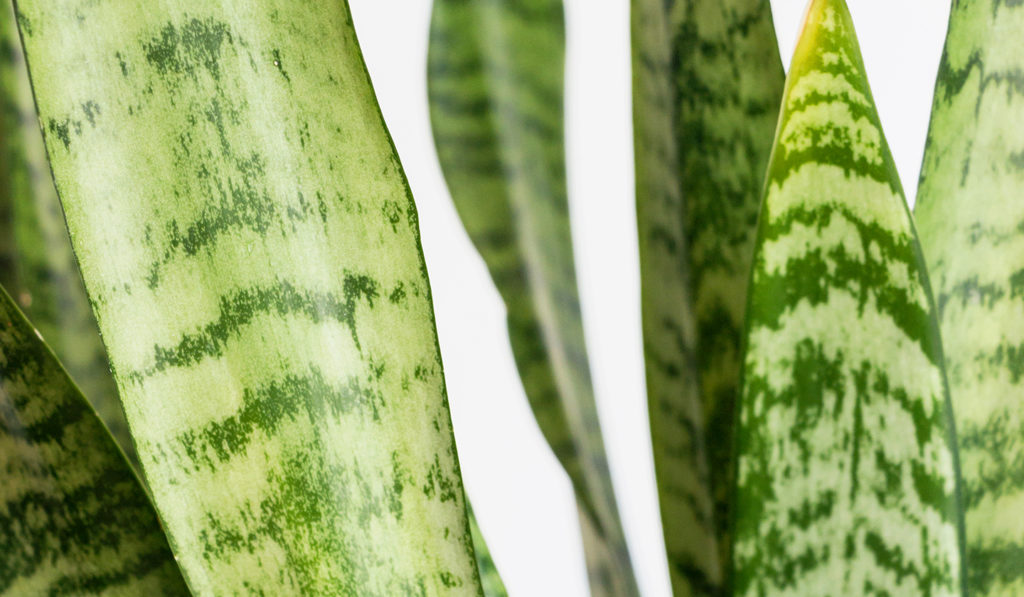
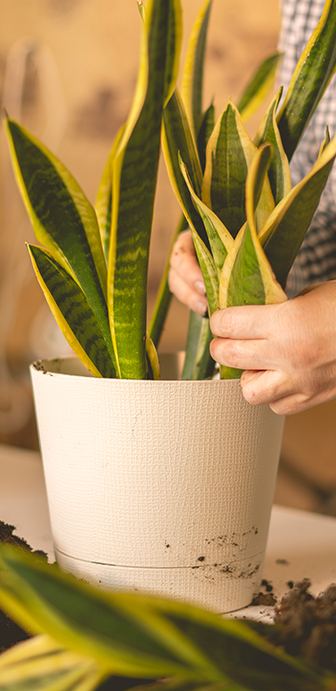
beyond the basics
-
soil & potting
It’s a desert plant, so use a light, well-draining potting soil like Miracle-Gro Cactus, Palm and Succulent Potting Mix. Or, use regular potting soil and add some potting sand or perlite. A layer of sand on the top will help prevent rot. Ensure the pot has good drainage. Snakes should never sit in water. Empty drainage trays if you see water collecting.
-
when to repot
Every 2 to 3 years in the Spring, especially in the earlier years. Increase the pot size by 2 inches each repotting. In later years you can replace the top couple inches of soil instead of completely repotting. Snake growing too fast? Slow the growth by trimming the roots.
-
propagation
Grab a sharp knife or scissors, find one of the healthiest leaves, and cut it off at the base of the plant. Then cut the leaf into multiple horizontal strips (about 3 inches each). Let the ends dry for two days then put them in water to stimulate root growth. This step could take 2 to 3 weeks. When you’ve got roots, you’re ready to pot.
-
pest control
Mealybugs are most common. When you do your regular dusting, inspect the leaves. Check out our Pest control section in Plant 101 for how to identify and deal with pests on your plant!
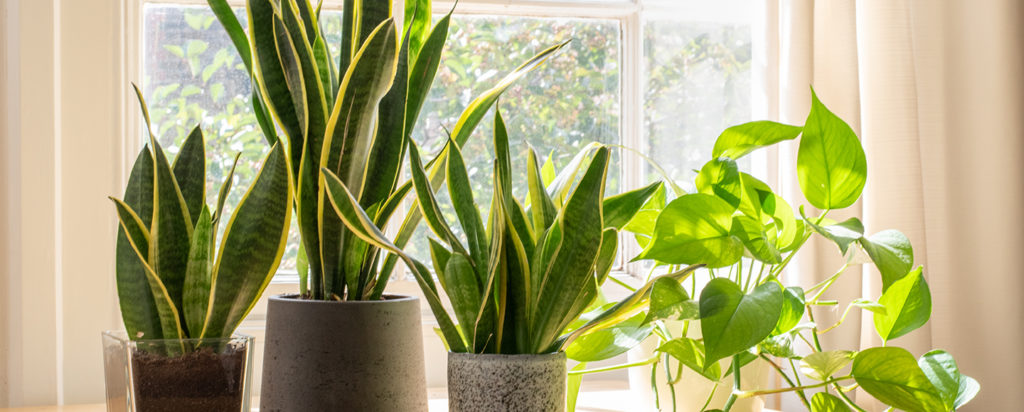
troubleshooting
-
why are the leaves falling sideways?
Multiple possibilities. All easily fixed. Firstly, this may not be a problem at all. Overly mature leaves naturally fall away to make room new growth. But if many leaves are falling over before their time, it’s probably over or under watering. If the soil is bone dry, add a moderate amount of water for a few days in a row. Then be more diligent with your watering routine. If the soil is soaked, check your drainage and let the soil fully dry before starting a better routine. Light issues: Snake plants do well in low light but if they’re getting no light leaves may start to keel over. Move into some nice, bright, indirect light. Other causes? Maybe your Snake plant has outgrown its pot. This can cause it to become root-bound. It’s time to repot in something at least 2 inches wider.
-
why do I have yellowing leaves?
Probably overwatering. Are the leaves also a bit mushy? These are signs of root rot. Not to worry, when caught early this is easily fixable. Reduce watering and ensure the soil dries out before watering. Check your pot’s drainage. Does it have a hole that allows excess water to escape? Help things dry by poking holes in the soil. This will get oxygen to the roots. You can also put the pot (with drainage holes) in a tray that’s lined with a layer of dry soil. It acts like a sponge to draw out extra moisture. Now, let’s check for root rot. Dig down and cut out any that look affected. If things are really bad, consider repotting entirely with new soil. For more information check out our Plant 101 section.
-
why does this snake have wrinkled leaves?
Under-watering. Check the soil. It’s probably bone dry. Instead of dousing it all at once. Give your Snake plant a medium amount of water three days in a row. Nice and easy. Make sure it’s never sitting in pools of water. Those droopy leaves should rebound by day three.

zz plant
aka zamioculcas zamiifolia, zuzu, emerald palm, zanzibar, zanzibar gem, eternity plant
ZZ has such impossibly gorgeous and glossy foliage that many people mistake them as fake. So glossy, so exotic and so low maintenance. In fact this sturdy stunner is sometimes mistaken as a fake plant. It may look too perfect be real, but it is! Meet to the Gem of Zanzibar, ZZ. Description: leaves so glossy and bright looks fake / thrives on neglect / easter and southern Africa / subtropical savannah / easy to grow / beginner plant
variations
There are a few varieties of ZZ, the Raven ZZ with black leaves, the Zenzi with curly bunched up leaves, the Dwarf ZZ or Zamicro which looks the same as a common ZZ but will never grow larger than 2 feet, and the Lucky classic which had more rounded leaves. You can also get variegated leaves on a ZZ.
light
flexible
Happiest in bright, indirect light. One of the few houseplants that can handle some hours of direct sun. But this easy-going beauty is also good in low light. So adaptable.
water + feeding
get dry between watering
Perhaps the only way to kill a ZZ is overwatering. It’s thick waxy coating and water-storing roots mean this plant does well with much less water than other plants. Make sure the top 1 to 2 inches are completely dry before rewatering. It also doesn’t need much feeding. Feed once a month max, in Spring and Summer. Even then, you can dilute the nutrients.
toxic
mildly toxic to humans and pets
Ingestion will cause mouth, stomach irritation and possible vomiting. ZZ’s sap may also cause skin irritation.
location
not fussy
ZZ can thrive almost anywhere. It truly is one of the easiest plants. It’s from Zanzibar, so it prefers the warmth.
humidity
flexible
Dry air is not a problem. It can handle humidity also. You can mist occasionally, but ZZ does well with no special treatment.
size
large friend
This plant can grow up to 5ft tall with a 3 to 4 foot spread.
pro tip
drought tolerant
ZZ plants have thick succulent roots and can live for months with little to no water. They much prefer to live on less water than too much.
fun fact
eternity plant
ZZ earned this nickname because it looks like ancient plants that predate the dinosaurs. Another reason may be its borderline miraculous resilience.
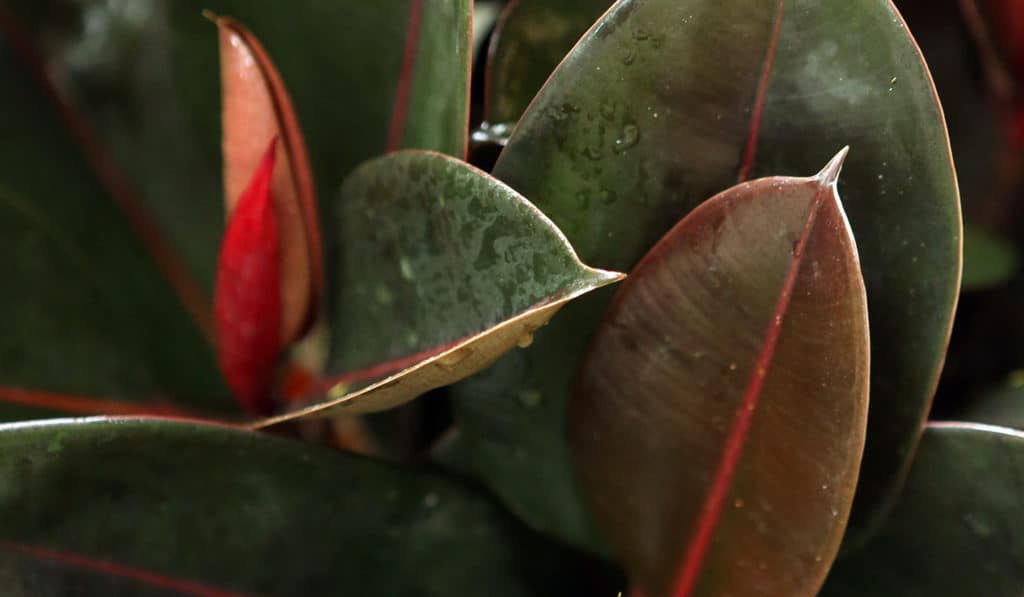
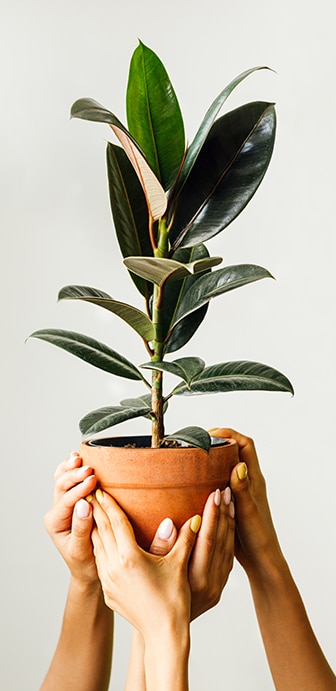
beyond the basics
-
soil & potting
Use a rich, well-draining, indoor potting soil, like Miracle-Gro® Indoor Potting Mix. Ensure your pot has good drainage. Don’t let it sit in water and if you notice water pooling in the drainage tray, empty it.
-
when to repot
Repot every 1 to 2 years in the Spring, especially with younger plants. Increase pot by 2 inches every time. When your Rubber plant is older and becomes a big fella, repotting gets hard! So you can just replace the top few inches of soil.
-
propagation
Be careful what you start, because these plants get big! Pick a stem showing thick, healthy leaves and cut halfway up the stem. Milky sap will come out, and it’s an irritant you want to avoid. Remove the bottom leaves to give yourself a nice stretch of stem. It’s not the easiest propagator, so you’ll need rooting hormone to encourage roots. Dip your stem in the hormone and pot it moist soil, like Miracle-Gro® Indoor Potting Mix.
-
pest control
Look for mealybugs, scale insects, and spider mites. During your regular leaf cleaning, inspect the underside of each leaf. Check out our Pest control section in Plant 101 for how to identify and deal with pests on your plant!
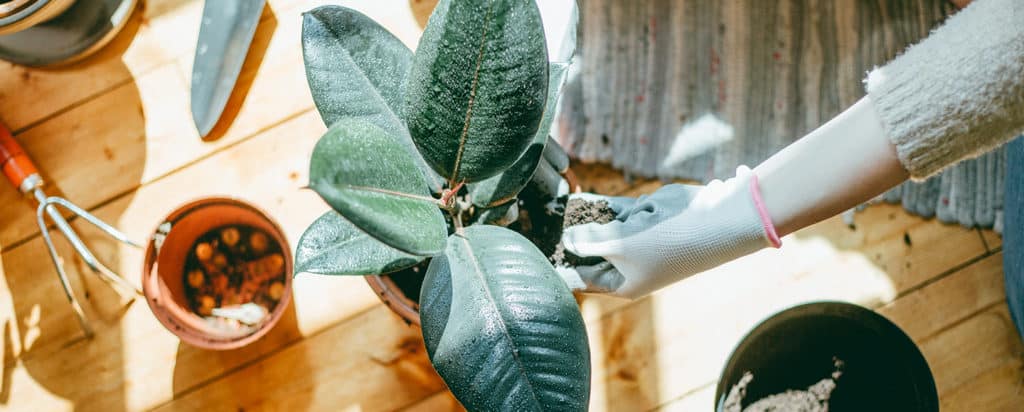
troubleshooting
-
why are there patchy, pale spots on leaves?
Too much direct sunlight. Rubber plants don’t like direct sun. It’s too hot on those big, broad leave, and they’ll lose moisture, causing these patchy pale spots. Shade the window or move your plant away from this direct sun. Sadly, the spots don’t heal, so consider removing the most damaged ones.
-
what’s with all the dropping leaves?
Rubber plants get stressed out easily. Any sudden change is likely to trigger leaf drop. Blasts of air conditioning or furnace heat. Cold drafts under a door. Being taken home from the nursery is also a big change in your plant’s life! Expect droppage. If you have not moved it recently and you can’t source any sudden temp changes then it could be overly dry air, or under watering and feeding. Review your care routine and your Rubber plant should… bounce back.
-
why are there dark Patches or spots on leaves?
Possible sunburn, or worse, leaf spot. If your Rubber plant is sitting in direct sunlight, it’s probably sunburn. Especially if it’s getting hot Summer sun. Move to still-bright indirect spot. If it’s not sunburn, it could be leaf spot, a fungal disease. Overwatering, especially in the winter, is usually the cause. First, avoid spreading to other plants by separating them physically. Remove all spotty leaves and check for plant debris in the pot. If you’re misting, stop. You want the leaves to get dry. Treat with fungicide.
-
why do I have yellowing, wilting leaves?
Probably root rot from overwatering. Do you also notice mushy stems and/or slower growth? These are all signs of root rot. Not to worry, when caught early this is easily fixable. Reduce watering and ensure the soil dries out before watering. Check your pot’s drainage. Does it have a hole that allows excess water to escape? Help things dry by poking holes in the soil. This will get oxygen to the roots. You can also put the pot (with drainage holes) in a tray that’s lined with a layer of dry soil. It acts like a sponge to draw out extra moisture. Now, let’s check for root rot. Dig down and cut out any that look affected. If things are really bad, consider repotting entirely with new soil. For more information check out our Plant 101 section.

zz plant
aka zamioculcas zamiifolia, zuzu, emerald palm, zanzibar, zanzibar gem, eternity plant
ZZ has such impossibly gorgeous and glossy foliage that many people mistake them as fake. So glossy, so exotic and so low maintenance. In fact this sturdy stunner is sometimes mistaken as a fake plant. It may look too perfect be real, but it is! Meet to the Gem of Zanzibar, ZZ. Description: leaves so glossy and bright looks fake / thrives on neglect / easter and southern Africa / subtropical savannah / easy to grow / beginner plant
variations
There are a few varieties of ZZ, the Raven ZZ with black leaves, the Zenzi with curly bunched up leaves, the Dwarf ZZ or Zamicro which looks the same as a common ZZ but will never grow larger than 2 feet, and the Lucky classic which had more rounded leaves. You can also get variegated leaves on a ZZ.
light
flexible
Happiest in bright, indirect light. One of the few houseplants that can handle some hours of direct sun. But this easy-going beauty is also good in low light. So adaptable.
water + feeding
get dry between watering
Perhaps the only way to kill a ZZ is overwatering. It’s thick waxy coating and water-storing roots mean this plant does well with much less water than other plants. Make sure the top 1 to 2 inches are completely dry before rewatering. It also doesn’t need much feeding. Feed once a month max, in Spring and Summer. Even then, you can dilute the nutrients.
toxic
mildly toxic to humans and pets
Ingestion will cause mouth, stomach irritation and possible vomiting. ZZ’s sap may also cause skin irritation.
location
not fussy
ZZ can thrive almost anywhere. It truly is one of the easiest plants. It’s from Zanzibar, so it prefers the warmth.
humidity
flexible
Dry air is not a problem. It can handle humidity also. You can mist occasionally, but ZZ does well with no special treatment.
size
large friend
This plant can grow up to 5ft tall with a 3 to 4 foot spread.
pro tip
drought tolerant
ZZ plants have thick succulent roots and can live for months with little to no water. They much prefer to live on less water than too much.
fun fact
eternity plant
ZZ earned this nickname because it looks like ancient plants that predate the dinosaurs. Another reason may be its borderline miraculous resilience.
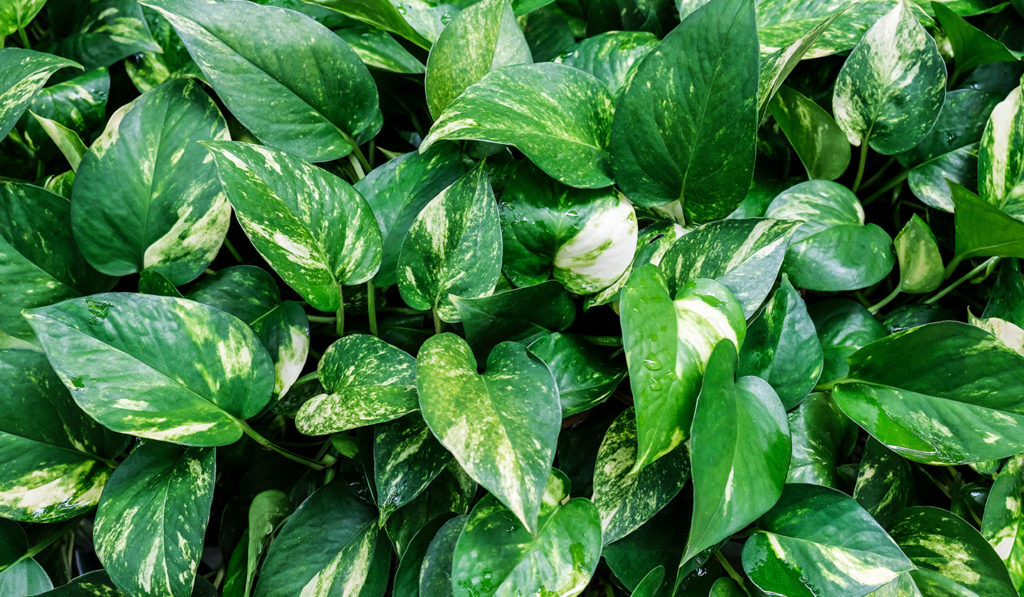
beyond the basics
-
soil + potting
Use a rich, well-draining, indoor potting soil, like Miracle-Gro® Indoor Potting Mix. Ensure your pot has good drainage. Don’t let it sit in water and if you notice water pooling in the drainage tray, empty it.
-
when to repot
Repot every 2 to 3 years in the Spring, especially with younger plants. Increase pot by 2 inches every time. When Pothos is more mature and fully grown, you can just replace the top few inches of soil.
-
propagation
Very easy with Pothos. Find a node or aerial root, cut just below the node and remove the lower leaves. Cutting can be put back in the soil, or in water. Cuttings will happily live in water for as long as you keep the jar topped up. This is a great way to add some green to darker, out-of-the-way places that are too small or awkward for a pot. For more information on propagation check out our propagation project page!
-
pest control
Prone to mealybugs and scale. During your routine leaf cleaning, inspect the underside. Check out our Pest control section in Plant 101 for how to identify and deal with pests on your plant!
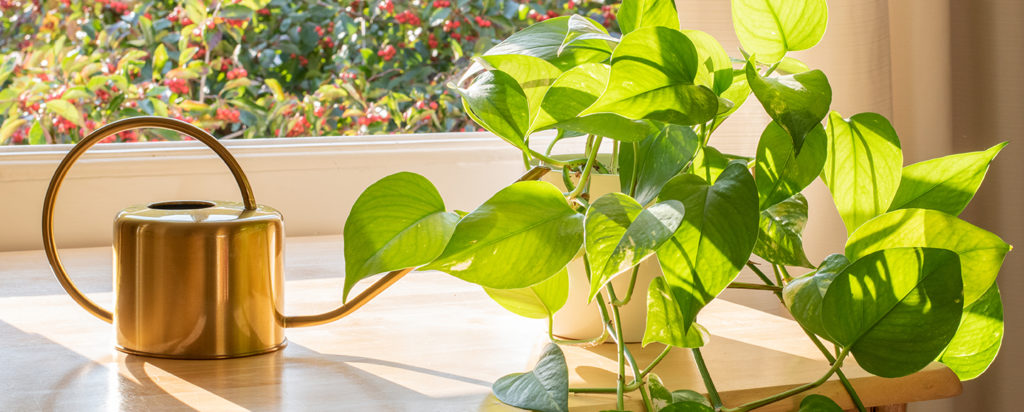
troubleshooting
-
why is my pothos ‘crying’?
Could be normal “guttation”, or signs of over watering. Pothos have a natural tendency to ‘cry’. This expulsion of water from leaf pores is called “guttation” and it’s usually nothing to worry about. Review your watering routine. If you’re allowing the top 1 to 2 inches of soil to completely dry between watering, you’re good. If you’re overwatering and letting your Pothos sit in water, just drain the standing water, let the soil dry out and water less in the future.
-
drooping or wilting leaves?
Needs water. Does your Pothos look wilted and droopy? Do those normally perky heart-shaeped leaves feel thinner? Your poor Pothos is crying out for a drink. Instead of doing one giant dump of water, water a little once per day for three days. You want the soil pleasantly moist, not super soggy. Your Pothos should bounce back in just a few days.
-
brown spots or patchy?
Leaf spot disease due to overwatering. Overly damp conditions make most plants susceptible to disease, even the mighty Pothos. Isolate your Pothos to avoid spreading to other plants. This may be the hardest part because those vines may run all over the house. Cut off all the affected leaves and any debris that’s fallen into the pot. If you’ve been misting, stop. If there’s another source of humidity like a humidifier, or it’s next to your shower, move the plant away until those spots are gone. Treat with a fungicide.
-
long parts of your trail leggy and without leaves?
Inconsistent care. Pothos’ vines travel far and wide! Often they venture into low light areas, where leaves tend to fall off. That means your Pothos is wasting energy to support empty vines that can’t grow leaves. The solution is simple. Cut the vine where healthy clusters of leaves generally stop. If your cutting has leaves at the end, you can trim it so there’s at least two nodes below the leaves, then propagate.

zz plant
aka zamioculcas zamiifolia, zuzu, emerald palm, zanzibar, zanzibar gem, eternity plant
ZZ has such impossibly gorgeous and glossy foliage that many people mistake them as fake. So glossy, so exotic and so low maintenance. In fact this sturdy stunner is sometimes mistaken as a fake plant. It may look too perfect be real, but it is! Meet to the Gem of Zanzibar, ZZ. Description: leaves so glossy and bright looks fake / thrives on neglect / easter and southern Africa / subtropical savannah / easy to grow / beginner plant
variations
There are a few varieties of ZZ, the Raven ZZ with black leaves, the Zenzi with curly bunched up leaves, the Dwarf ZZ or Zamicro which looks the same as a common ZZ but will never grow larger than 2 feet, and the Lucky classic which had more rounded leaves. You can also get variegated leaves on a ZZ.
light
flexible
Happiest in bright, indirect light. One of the few houseplants that can handle some hours of direct sun. But this easy-going beauty is also good in low light. So adaptable.
water + feeding
get dry between watering
Perhaps the only way to kill a ZZ is overwatering. It’s thick waxy coating and water-storing roots mean this plant does well with much less water than other plants. Make sure the top 1 to 2 inches are completely dry before rewatering. It also doesn’t need much feeding. Feed once a month max, in Spring and Summer. Even then, you can dilute the nutrients.
toxic
mildly toxic to humans and pets
Ingestion will cause mouth, stomach irritation and possible vomiting. ZZ’s sap may also cause skin irritation.
location
not fussy
ZZ can thrive almost anywhere. It truly is one of the easiest plants. It’s from Zanzibar, so it prefers the warmth.
humidity
flexible
Dry air is not a problem. It can handle humidity also. You can mist occasionally, but ZZ does well with no special treatment.
size
large friend
This plant can grow up to 5ft tall with a 3 to 4 foot spread.
pro tip
drought tolerant
ZZ plants have thick succulent roots and can live for months with little to no water. They much prefer to live on less water than too much.
fun fact
eternity plant
ZZ earned this nickname because it looks like ancient plants that predate the dinosaurs. Another reason may be its borderline miraculous resilience.
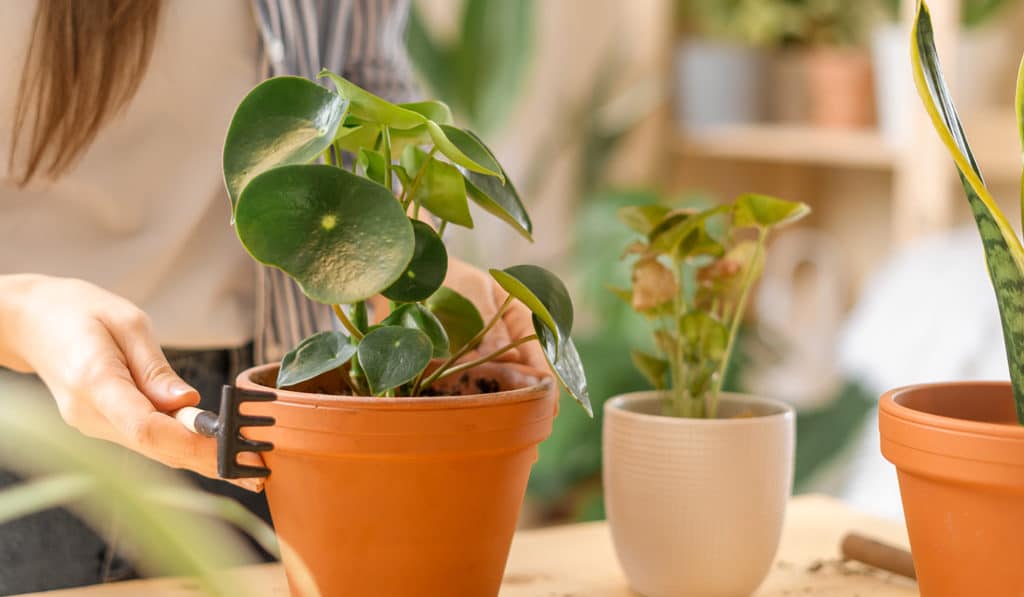
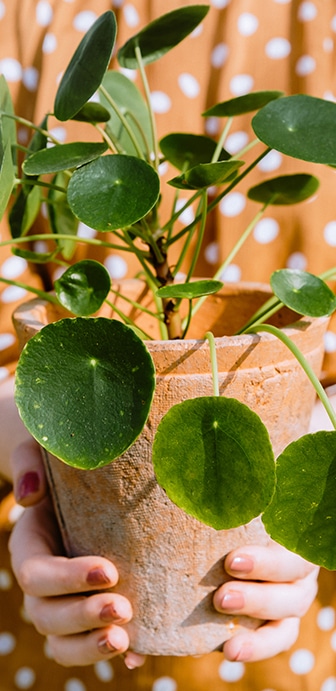
beyond the basics
-
soil & potting
This plant likes a light, well-draining soil like Miracle-Gro Cactus, Palm and Succulent Potting Mix. Or add some potting sand or perlite to regular potting soil. Your pot must have good drainage and don’t let Pilea sit in water. If you see water collecting in the drainage tray, dump it.
-
when to repot
Repot every 1 to 2 years in the Spring, especially with younger plants. Increase pot by 2 inches every time. If dealing with a more mature, fully grown plant you can just replace the top few inches of soil.
-
propagation
So easy, because Pilea is self-propagating. It creates tiny offshoots also known as ‘pups’. You can leave them on the plant, or create a new one. Wait until your Pilea pup is at least a few inches tall. Gently dig under the pup and cut (or gently pull) the plant free, ensuring you get roots. Put the pup in some water to grow stronger roots, or plant directly in soil. You have a new mini Pilea that makes a perfect gift!
-
pest control
Pileas are bug resistant, but pests are still possible. Inspect under the leaves when doing your regular dusting & cleaning. Check out our Pest control section in Plant 101 for how to identify and deal with pests on your plant!
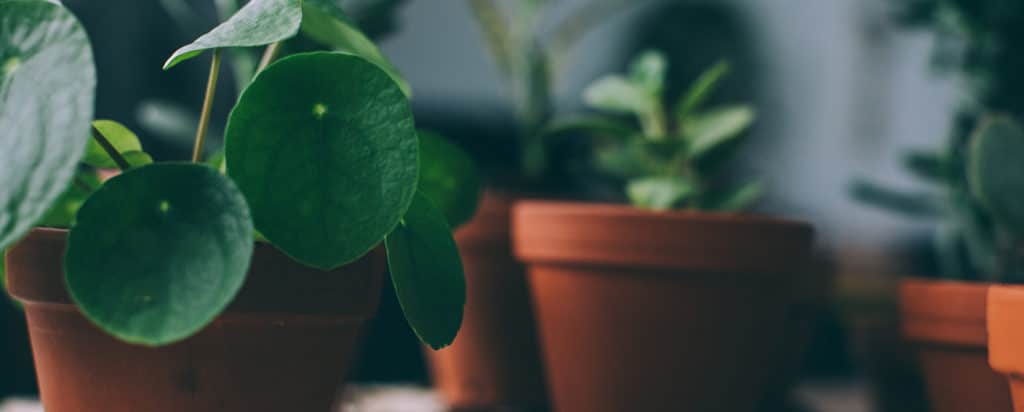
troubleshooting
-
leaves curved in, or out?
Light and water are incorrect. If the leaves are curled inwards, your Pilea is probably dehydrated. It’s not getting enough water, or it’s getting too much sun. On the flipside, If the leaves are curled outwards it’s probably too much water or not enough light. Check your soil before watering and ensure the top two inches of soil are dry before watering. Time between watering varies by plant and how much light they’re getting.
-
leaves turning yellow or dropping off?
Where are they yellowing? If only the bottom leaves are yellowing and dropping, there’s no problem. That’s normal Pilea behaviour. But If the whole plant is yellowing, you’re probably overwatering. When doing your watering routine, make sure the top 1 to 2 inches of soil are dry before watering.
-
leaves facing in one direction?
Rotate your plant! Pilea’s love to grow towards the sun. This can cause them to become one side heavy or grow unevenly. You should remember to turn your plant every time you water to allow the plant to grow evenly.
-
mold on the surface soil?
Overwatering, too little time between watering. Mold (and even mushrooms) growing on your soil is not a direct threat. But it IS a sign of overwatering. Root rot can follow if not addressed. Water less frequently and make sure you let the top two inches of soil fully dry before watering. Ensure you have proper drainage. If things look really moldy, you can remove the top inch or so of soil.
-
powdery, white patches on leaves?
Powdery mildew. Like mold, this isn’t dangerous, but it makes your precious Pilea less pretty! So it’s got to go. Bad air circulation is usually the cause. Remove affected leaves and move your plant somewhere with better air circulation.

zz plant
aka zamioculcas zamiifolia, zuzu, emerald palm, zanzibar, zanzibar gem, eternity plant
ZZ has such impossibly gorgeous and glossy foliage that many people mistake them as fake. So glossy, so exotic and so low maintenance. In fact this sturdy stunner is sometimes mistaken as a fake plant. It may look too perfect be real, but it is! Meet to the Gem of Zanzibar, ZZ. Description: leaves so glossy and bright looks fake / thrives on neglect / easter and southern Africa / subtropical savannah / easy to grow / beginner plant
variations
There are a few varieties of ZZ, the Raven ZZ with black leaves, the Zenzi with curly bunched up leaves, the Dwarf ZZ or Zamicro which looks the same as a common ZZ but will never grow larger than 2 feet, and the Lucky classic which had more rounded leaves. You can also get variegated leaves on a ZZ.
light
flexible
Happiest in bright, indirect light. One of the few houseplants that can handle some hours of direct sun. But this easy-going beauty is also good in low light. So adaptable.
water + feeding
get dry between watering
Perhaps the only way to kill a ZZ is overwatering. It’s thick waxy coating and water-storing roots mean this plant does well with much less water than other plants. Make sure the top 1 to 2 inches are completely dry before rewatering. It also doesn’t need much feeding. Feed once a month max, in Spring and Summer. Even then, you can dilute the nutrients.
toxic
mildly toxic to humans and pets
Ingestion will cause mouth, stomach irritation and possible vomiting. ZZ’s sap may also cause skin irritation.
location
not fussy
ZZ can thrive almost anywhere. It truly is one of the easiest plants. It’s from Zanzibar, so it prefers the warmth.
humidity
flexible
Dry air is not a problem. It can handle humidity also. You can mist occasionally, but ZZ does well with no special treatment.
size
large friend
This plant can grow up to 5ft tall with a 3 to 4 foot spread.
pro tip
drought tolerant
ZZ plants have thick succulent roots and can live for months with little to no water. They much prefer to live on less water than too much.
fun fact
eternity plant
ZZ earned this nickname because it looks like ancient plants that predate the dinosaurs. Another reason may be its borderline miraculous resilience.
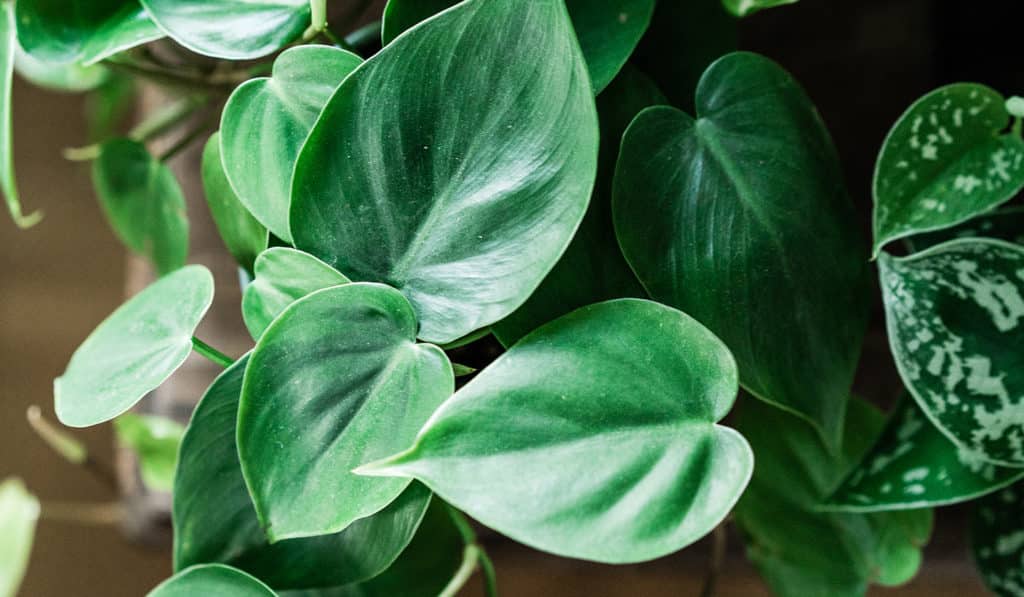
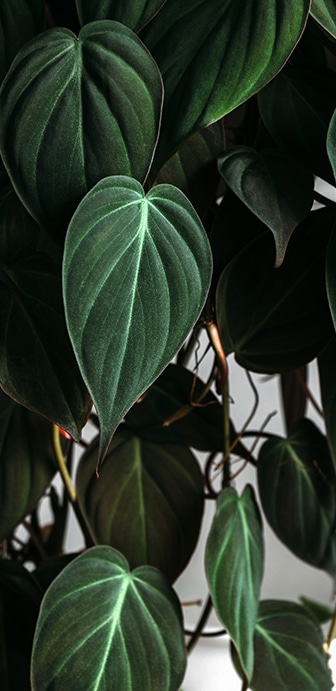
beyond the basics
-
soil & potting
Use a rich, well-draining, indoor potting soil, like Miracle-Gro® Indoor Potting Mix. Ensure your pot has good drainage. If you notice water pooling in the drainage tray, empty it.
-
when to repot
Repot every 2 years in the spring, especially with younger plants. Increase pot by 2 inches every time. If dealing with a more mature, fully grown plant you can just replace the top few inches of soil.
-
propogation
If you have a node or aerial root this plant is very easy to propagate. Cut just below the node and remove the lower leaves. Put in water and watch the roots grow in just a few short weeks! For more information on propagation check out our propagation project page!
-
pest control
Prone to mealybugs. Check the underside of leaves regularly when cleaning. Check out our Pest control section in Plant 101 for how to identify and deal with pests on your plant!
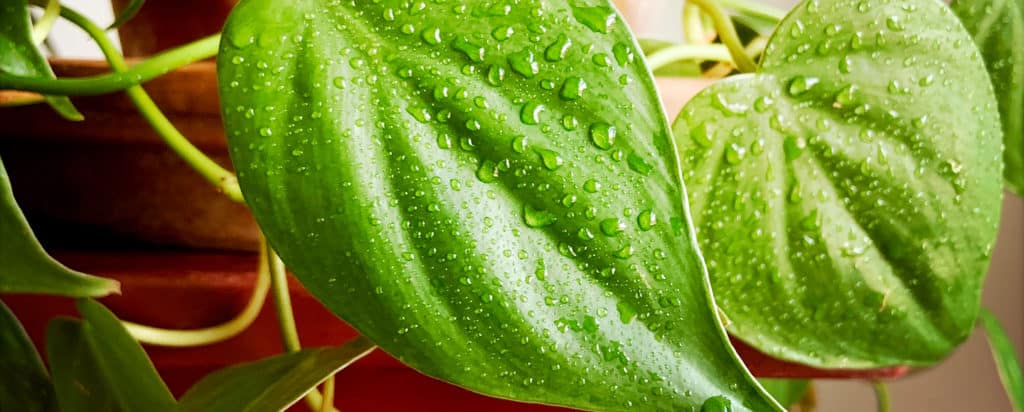
troubleshooting
-
yellowing lower leaves?
Low temperatures or drafts are probably the cause. Try moving your plant to a new location where it is clear of any drafts. Philodendrons like it warm, between 60 and 75 F (16 and 24C) It could also be underwatering or under fertilizing. Ensure you’re watering regularly when the top inch of soil becomes dry.
-
leaves dropping?
Probably a cold draft. Move to warm location that’s clear of any drafty windows or the air conditioning vent. It’s a hardy plant but still likes temps between 60 and 75 F (16 and 24C)
-
brown edges on the leaves?
Various. The soil could be too dry. Water regularly when the top inch of soil gets dry. Water until the soil is moist, but not soggy. If the air feels dry and the temp is over 75F (24C,) mist the leaves regularly. Consider a humidifier, or put the pot on a pebble-filled tray of water (making sure the pot is not touching the water). Philodendrons don’t like cold drafts, so this could also be the problem. Move away from cold windows or AC vents.

zz plant
aka zamioculcas zamiifolia, zuzu, emerald palm, zanzibar, zanzibar gem, eternity plant
ZZ has such impossibly gorgeous and glossy foliage that many people mistake them as fake. So glossy, so exotic and so low maintenance. In fact this sturdy stunner is sometimes mistaken as a fake plant. It may look too perfect be real, but it is! Meet to the Gem of Zanzibar, ZZ. Description: leaves so glossy and bright looks fake / thrives on neglect / easter and southern Africa / subtropical savannah / easy to grow / beginner plant
variations
There are a few varieties of ZZ, the Raven ZZ with black leaves, the Zenzi with curly bunched up leaves, the Dwarf ZZ or Zamicro which looks the same as a common ZZ but will never grow larger than 2 feet, and the Lucky classic which had more rounded leaves. You can also get variegated leaves on a ZZ.
light
flexible
Happiest in bright, indirect light. One of the few houseplants that can handle some hours of direct sun. But this easy-going beauty is also good in low light. So adaptable.
water + feeding
get dry between watering
Perhaps the only way to kill a ZZ is overwatering. It’s thick waxy coating and water-storing roots mean this plant does well with much less water than other plants. Make sure the top 1 to 2 inches are completely dry before rewatering. It also doesn’t need much feeding. Feed once a month max, in Spring and Summer. Even then, you can dilute the nutrients.
toxic
mildly toxic to humans and pets
Ingestion will cause mouth, stomach irritation and possible vomiting. ZZ’s sap may also cause skin irritation.
location
not fussy
ZZ can thrive almost anywhere. It truly is one of the easiest plants. It’s from Zanzibar, so it prefers the warmth.
humidity
flexible
Dry air is not a problem. It can handle humidity also. You can mist occasionally, but ZZ does well with no special treatment.
size
large friend
This plant can grow up to 5ft tall with a 3 to 4 foot spread.
pro tip
drought tolerant
ZZ plants have thick succulent roots and can live for months with little to no water. They much prefer to live on less water than too much.
fun fact
eternity plant
ZZ earned this nickname because it looks like ancient plants that predate the dinosaurs. Another reason may be its borderline miraculous resilience.
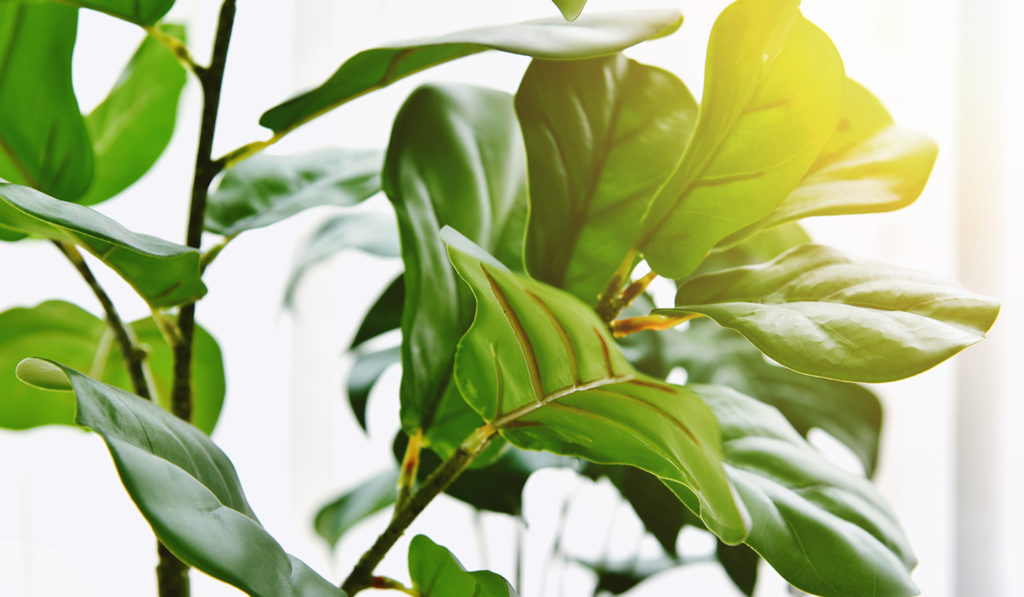
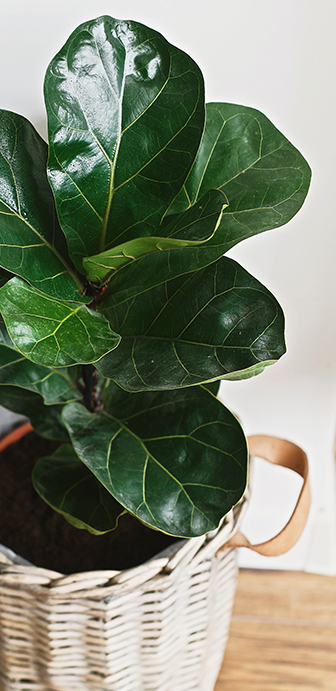
beyond the basics
-
soil & potting
Use a rich, well-draining, indoor potting soil, like Miracle-Gro® Indoor Potting Mix. Ensure your pot has good drainage. If you notice water pooling in the drainage tray, empty it.
-
when to repot
Every 2-3 years in the Spring, especially in the earlier years. Increase the pot size by 2 inches each repotting. When your Fig is all grown up, you can get away with just replacing the top few inches of soil.
-
propagation
Find a stem with 3-4 leaves and cut just below the lowest leaf. Now remove the lower leaves to make room for root growth. Place your stem in a jar of water. Figs can be stubborn to root, so add some rooting hormone to the water.
-
pest control
Fiddle Figs are prone to mealybugs, scale insects, and spider mites. Make a routine of dusting and checking under the leaves. Our pest control section in Plant 101 will help you identify and deal with pesky plant pests!
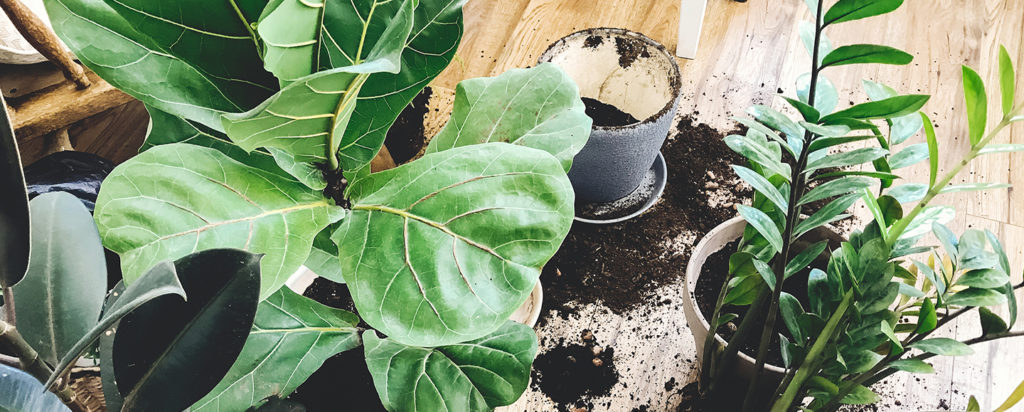
troubleshooting
-
sudden leaf loss?
Your friend is stressed out. Figs don’t like sudden changes to their surroundings. Often it’s blasts of hot or cold air a nearby vent. Moving from the nursery to your home is a shock for this gentle giant. If there haven’t been any sudden changes, it could be overly dry air. It could also be too much or too little water. Or too much or too little food. This plant is not the easiest! Review your placement and care routine, and keep doing your best. The leaves should grow back.
-
dark patches or spots on leaves?
Possibly a sunburn, or maybe leaf spot. If your Fiddle Fig gets direct sunlight it’s probably sunburn. Lots of indirect light is good but direct sun is bad. If that’s not it, it could be a fungal disease called leaf spot. Overwatering or an overly damp environment are the cause. Stop the spread to other plats, make sure leaves aren’t near each other. Remove infected leaves, including any that have fallen into the pot. If you’re misting, stop. Treat with fungicide as directed.
-
leaf tips turning brown?
Low humidity, not enough water or irregular watering. Give more attention to watering. Routines matter for this plant. Ensure it’s regular and thorough and that the entire root ball is getting wet. Check the room temp. If it’s over 75 F/24 C and the air feels dry, mist the leaves regularly and consider a humidifier. Or put the pot on a pebble filled tray of water. Make sure the pot doesn’t touch the water.
Make sure you are watering the plant thoroughly and at regular intervals, getting the whole root ball wet.
-
yellowing and wilting leaves?
Probably root rot from overwatering. Do you also notice mushy stems and/or slower growth? These are all signs of root rot. Not to worry, when caught early this is easily fixable. Reduce watering and ensure the soil dries out before watering. Check your pot’s drainage. Does it have a hole that allows excess water to escape? Help things dry by poking holes in the soil. This will get oxygen to the roots. You can also put the pot (with drainage holes) in a tray that’s lined with a layer of dry soil. It acts like a sponge to draw out extra moisture. Now, let’s check for root rot. Dig down and cut out any that look affected. If things are really bad, consider repotting entirely with new soil. For more information check out our Plant 101 section.

zz plant
aka zamioculcas zamiifolia, zuzu, emerald palm, zanzibar, zanzibar gem, eternity plant
ZZ has such impossibly gorgeous and glossy foliage that many people mistake them as fake. So glossy, so exotic and so low maintenance. In fact this sturdy stunner is sometimes mistaken as a fake plant. It may look too perfect be real, but it is! Meet to the Gem of Zanzibar, ZZ. Description: leaves so glossy and bright looks fake / thrives on neglect / easter and southern Africa / subtropical savannah / easy to grow / beginner plant
variations
There are a few varieties of ZZ, the Raven ZZ with black leaves, the Zenzi with curly bunched up leaves, the Dwarf ZZ or Zamicro which looks the same as a common ZZ but will never grow larger than 2 feet, and the Lucky classic which had more rounded leaves. You can also get variegated leaves on a ZZ.
light
flexible
Happiest in bright, indirect light. One of the few houseplants that can handle some hours of direct sun. But this easy-going beauty is also good in low light. So adaptable.
water + feeding
get dry between watering
Perhaps the only way to kill a ZZ is overwatering. It’s thick waxy coating and water-storing roots mean this plant does well with much less water than other plants. Make sure the top 1 to 2 inches are completely dry before rewatering. It also doesn’t need much feeding. Feed once a month max, in Spring and Summer. Even then, you can dilute the nutrients.
toxic
mildly toxic to humans and pets
Ingestion will cause mouth, stomach irritation and possible vomiting. ZZ’s sap may also cause skin irritation.
location
not fussy
ZZ can thrive almost anywhere. It truly is one of the easiest plants. It’s from Zanzibar, so it prefers the warmth.
humidity
flexible
Dry air is not a problem. It can handle humidity also. You can mist occasionally, but ZZ does well with no special treatment.
size
large friend
This plant can grow up to 5ft tall with a 3 to 4 foot spread.
pro tip
drought tolerant
ZZ plants have thick succulent roots and can live for months with little to no water. They much prefer to live on less water than too much.
fun fact
eternity plant
ZZ earned this nickname because it looks like ancient plants that predate the dinosaurs. Another reason may be its borderline miraculous resilience.
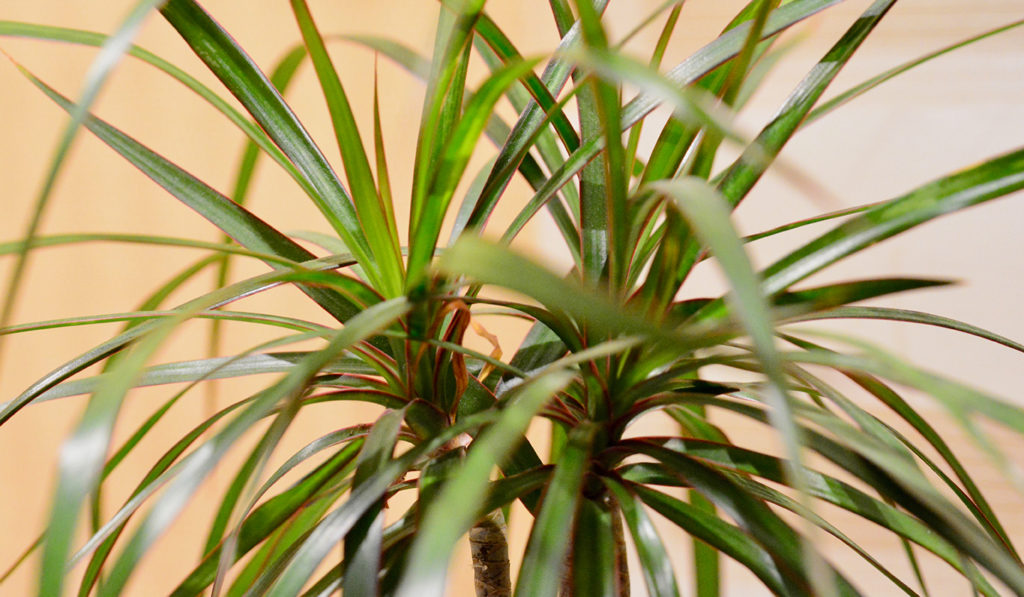
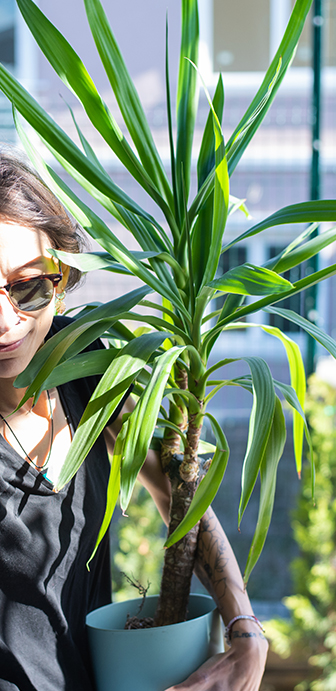
beyond the basics
-
soil & potting
This plant likes a light, well-draining soil like Miracle-Gro Cactus, Palm and Succulent Potting Mix. Or add some potting sand or perlite to regular potting soil. A layer of sand on the top will also help prevent rot. You pot must have good drainage and don’t let Dracaena sit in water. If you see water collecting in the drainage tray, dump it.
-
when to repot
Every 2-3 years in the Spring, especially in the earlier years. Increase the pot size by 2 inches each repotting. When your Dracaena is all grown up, you can get away with just replacing the top few inches of soil.
-
propagation
Cut a stem off the plant, and remove the lower leaves. Put the cutting in water to stimulate root growth. Then cut a 2 to 4 inch stub off the bottom of a stem and insert it halfway into a dry potting mix like Miracle-Gro Cactus, Palm and Succulent Potting Mix.
-
pest control
Most common pests are scale insects and mealybugs. Check under leaves when you’re dusting. See our Pest control section in Plant 101 for how to identify and deal with pests on your plant!
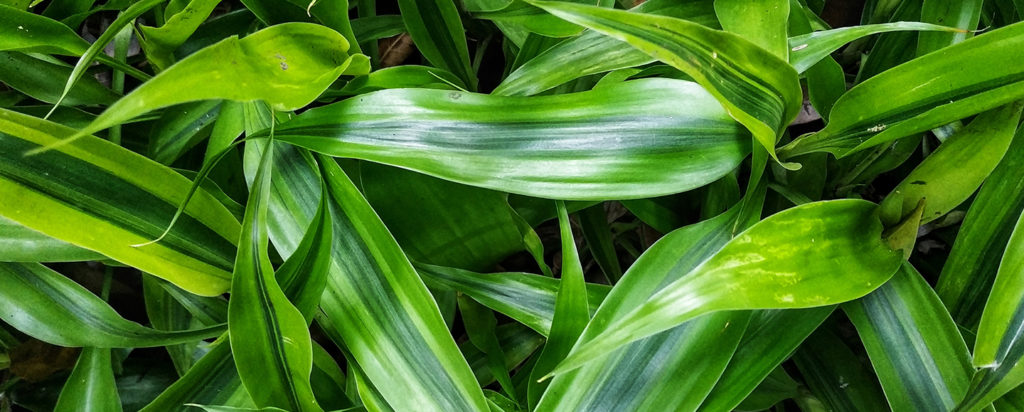
troubleshooting
-
brown tips on leaves?
Not enough water, or dry air. Most common in winter when furnaces are running.
Check soil more often and water when mostly dry. Add a humidifier to the room. Mist regularly. Put the pot on a pebble-filled tray of water. Consider moving to a room with more humidity like bathroom or kitchen.
-
yellowing leaves at the base?
Not really a problem! This is natural. That’s how Dracaenas grow. Older leaves fall off to allow for new ones. You can also gently pull off yellowed leaves. If new leaves are growing, everything is fine.
-
wilting leaves?
Overwatering or possible root rot. Wait until soil is medium dry between watering and ensure the pot has good drainage. If the wilt is bad, allow the soil to completely dry before watering. If the problem persists, check for root rot and remove any affected roots. Other moisture control techniques: Poke holes in soil to let oxygen at the roots. Put the pot (with drainage holes) in a tray lined with dry soil. Or go for a total do-over, and repot with a soil that’s formulated for drainage like Miracle-Gro Cactus, Palm and Succulent Potting Mix. For more information check out our Plant 101 section.
-
soft discoloured stems?
Overwatering causing root and stem rot. Cut back any soft, rotting stems. Remove your Dracaena from the pot and cut away any black, mushy roots. Get a sterilised new pot and start over. If the roots are all mush, you can still save your plant baby! Propagate from the top of the plant.
-
plant not growing?
Not enough light. Dracaena is cool hanging out in low light corners of your house, but it takes brighter (indirect) light to make it grow. This gives you the power to control the height of your plant! When you’re at the right height, move to a shadier spot.
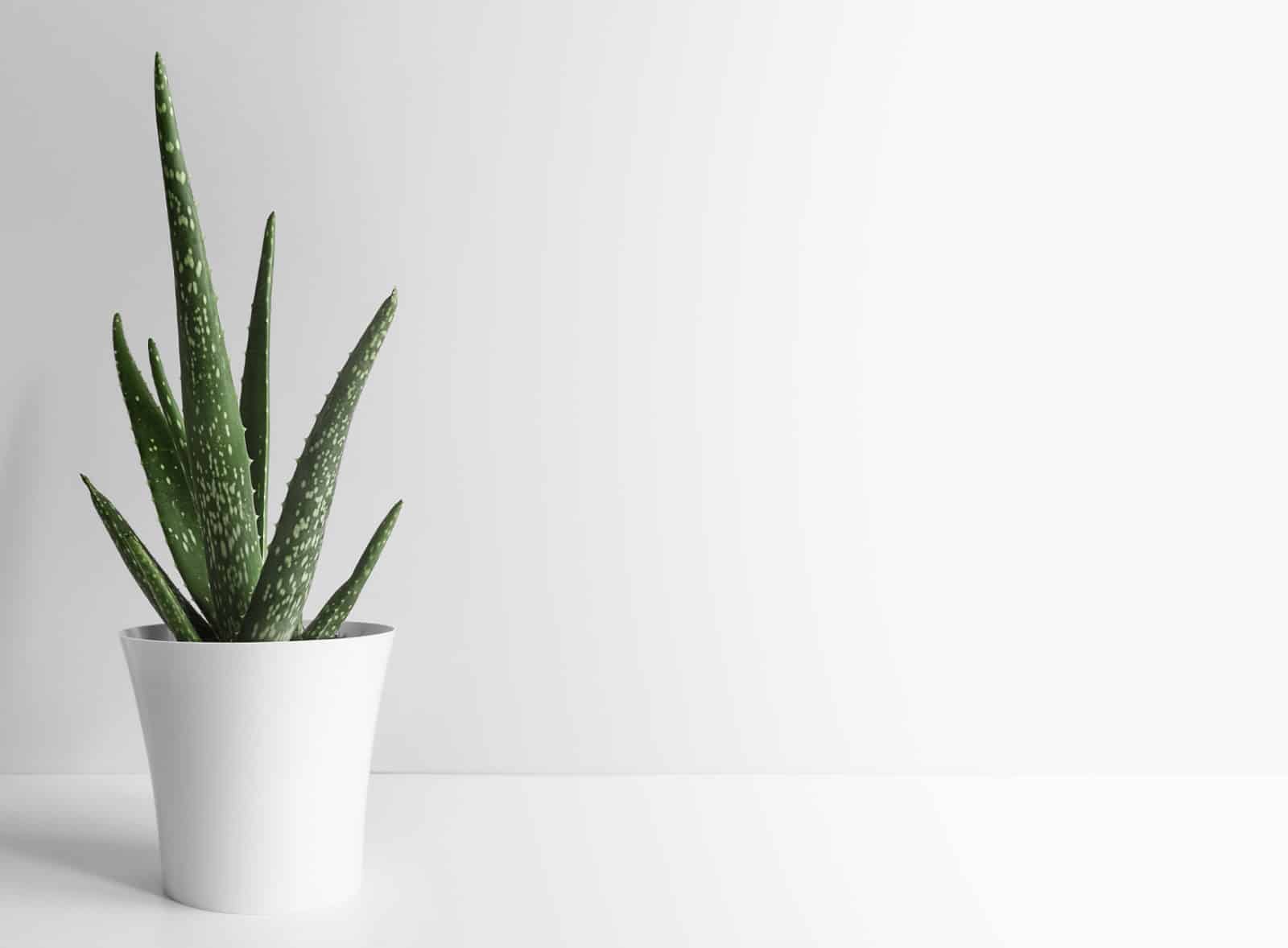
aloe vera
aka aloe barbadensis
Say “Ola” to this easy to grow succulent. Often touted as a “miracle” plant for its skin soothing gel, but the real miracle is how cute they look. An all-around great plant for rookies and exerts alike. Description: easy to grow succulent / soothes burns and skin irritations / southeast Arabian Peninsula / tropical
variations
Aloe Vera has a whopping 250 varieties. So many wonderful little differences to mix and match.
light
bright, indirect light
Find a spot with plenty of indirect light, and ideally a few hours of direct light.
water + feeding
allow to mostly dry out between watering
The top inch should be dry before watering again. Don’t overwater! It’s a desert plant. Feed once in spring, and once in summer.
toxic
safe on skin post likely toxic to ingest
Aloe gel is safe and soothing on the skin. You can even eat some varieties, but note! Most can cause indigestion, vomiting and airway irritation if eaten. Unless you’re 100% sure, keep away from kids and pets.
location
adaptable
Comfy with average indoor temperatures. Prefers things on the warmer side and doesn’t like drafts.
humidity
not an issue
Appreciates an occasional misting to control dust. Humidity levels aren’t a concern for this hearty little fella.
size
small to medium
Usually bought small and can to about 2 feet.
pro tip
water at soil level
Aloe doesn’t like water pooling in the creases between its leaves. That can cause leaf rot.
fun fact
it’s a super soother
Those thick, juicy leaves contain a soothing green gel that can be applied directly to burns (especially sun burns) and bug bites. External use only! It’s toxic to ingest.
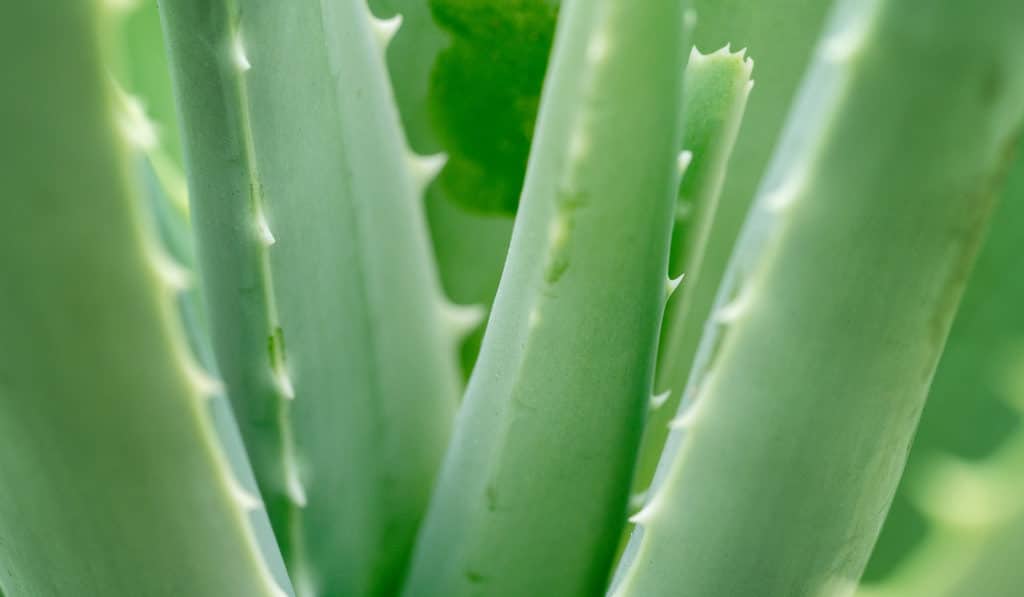
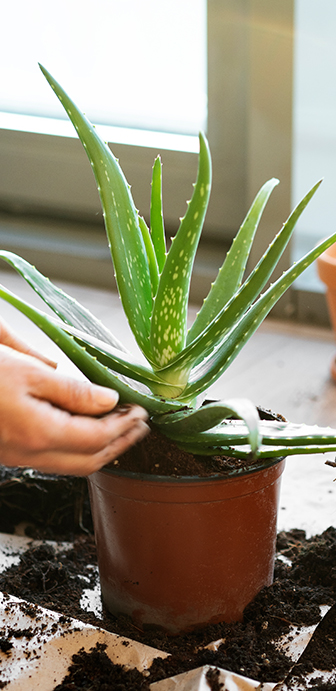
beyond the basics
-
soil & potting
Use a light, well-draining potting soil like Miracle-Gro Cactus, Palm and Succulent Potting Mix. Or, use regular potting soil and add some potting sand or perlite. A layer of sand on the top will help prevent rot. Ensure the pot has good drainage and aloe should never sit in water. Empty drainage trays if you see water collecting.
-
when to repot
Every 3-4 years in the spring. Especially when they’re small and growing. Increase pot diameter by 2 inches each time, and refresh the top few inches of soil. Growing too fast? You can slow the growth by trimming the roots.
-
propagation
Aloe self-propagates. It will make baby offshoots (also called ‘pups’). Leave pups on the main plant or, pot as a separate plant! Wait until the pup is at least 2” tall, then dig under the pup and find the roots at the base. Gently tug or trim the roots, they are key to the pup’s survival. You now have a new plant baby! See Soil + Potting above for planting instructions.
-
pest control
Aloe is prone to scale insects on the leaves. See our Pest control section in Plant 101 for how to identify and deal with pests on your plant!
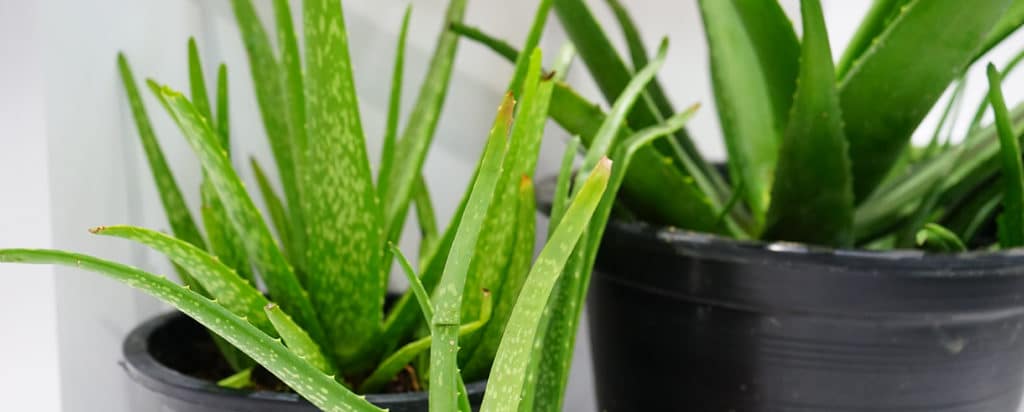
troubleshooting
-
leaves turning brown, red or reddish brown?
Variety of reasons. It could be too much summer sun, overwatering, or roots damage.
First, try moving your plant to a spot with less direct sunlight (but still bright). Reduce watering. If your little aloe buddy doesn’t recover check the roots for damage.
-
dark spots? brown or mushy leaves?
Probably overwatering. Caught early, this problem is easily corrected. Water at soil level and avoid spilling water on the leaves, cuz the pooling water can cause rot. Two inches of sand on top of the soil will help with drainage. Reduce watering and allow plant to dry out completely between watering. Ensure your pot has a drainage hole to let excess water out.
Other tricks: Poke holes in soil to get oxygen to the roots. Put a damp pot (with drainage holes) in a tray or dry soil, to suck up that extra moisture. Check the roots and remove any that have root rot. Consider repotting with new soil if things are a damp mess. For more information check out our Plant 101 section.
-
pale or yellowing leaves?
Overwatering or not enough light. Is the entire plant turning pale or yellow? It needs more light. Move to a brighter spot, watch out for soil dampness and avoid over watering.
-
shrunken, wrinkled leaves?
Your plant needs a drink. But don’t overdo it! Give it a small amount and also mist the leaves. Do this three days in a row. The leaves should rebound, getting nice and plump.
-
aloe not growing?
Not enough light. If your aloe isn’t growing, or the new growth is pale in colour, it’s crying out for more light. Most houseplants don’t like direct sun, but this desert-born baby likes it! A little direct sun every day is good, especially in darker winter months. Find a brighter spot and get growing.
